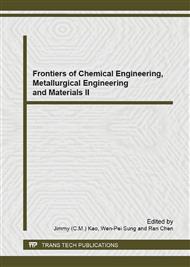p.131
p.137
p.142
p.145
p.149
p.153
p.157
p.161
p.165
Study on the Separation of Azeotrope of Tetrahydrofuran-Water Using a Combined Method of Extractive and General Distillation
Abstract:
As an important solvent, tetrahydrofuran has broad applications. Due to its process of production, water will be mixed into the product and should be removed. However, tetrahydrofuran will form a minimum boiling azeotrope with water, which has a boiling point of 63.4°C, so general distillation can not separate them. Common methods to solve this include extractive distillation, pressure swing distillation, azeotropic distillation, pervaporation and so on. In this experiment, we coupled extractive distillation and general distillation, selecting ethylene glycol as the extractant, and successfully dehydrated the azeotrope. The mass fraction of water is reduced from 18% to less than 500ppm,which matches the requirement.
Info:
Periodical:
Pages:
149-152
Citation:
Online since:
September 2013
Authors:
Keywords:
Price:
Сopyright:
© 2013 Trans Tech Publications Ltd. All Rights Reserved
Share:
Citation:


